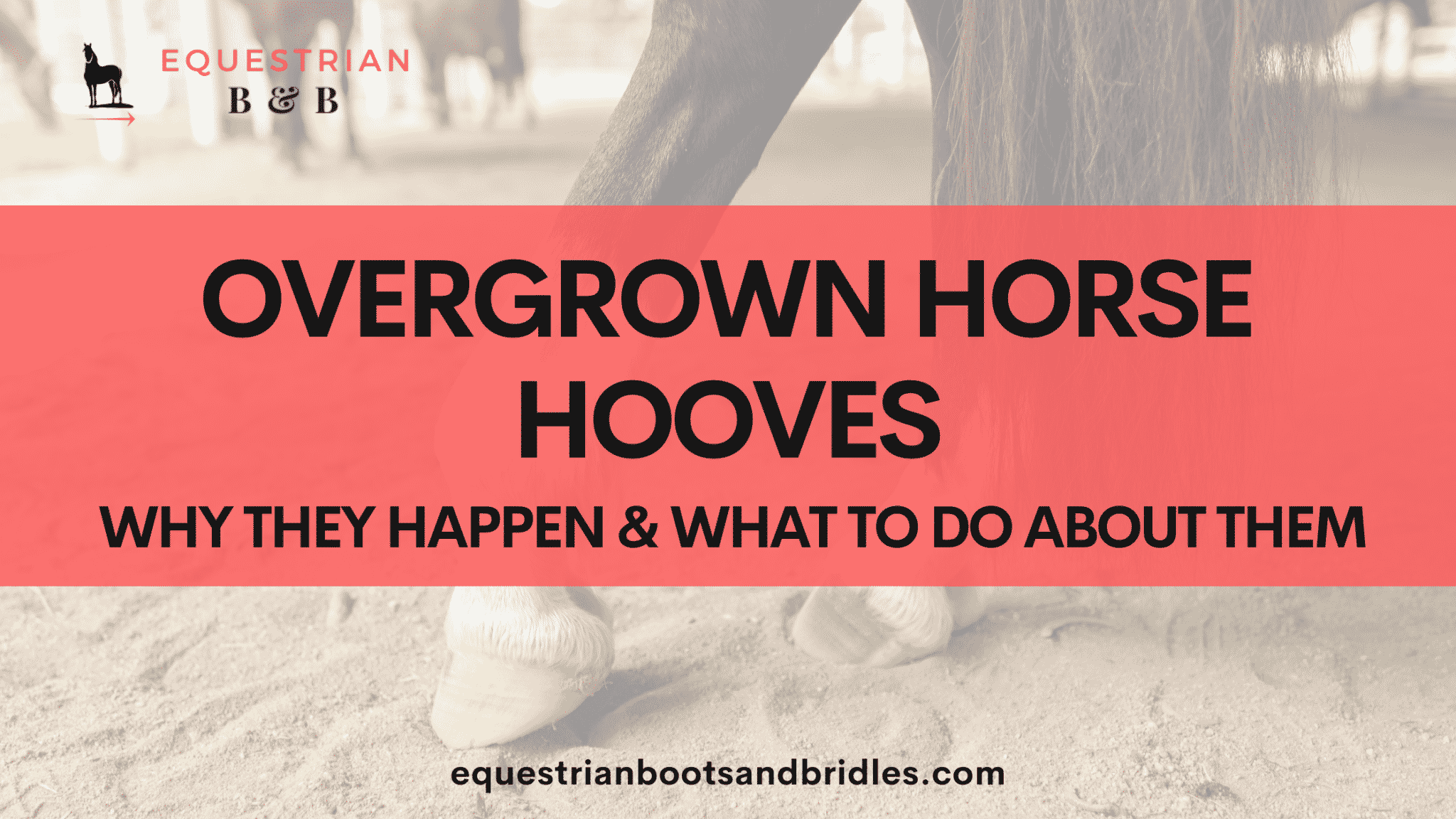Ever been on a trippy or footsore horse before? It’s not fun. Fortunately, you can dismount, but your horse has to live with their sore hooves. Hoof care and maintaining your horse’s hooves are an important part of responsible horse ownership.
Overgrown hooves are a problem that frequently happens because of irregular farrier work, conformation of your horse, and environmental factors. Knowing your horse, working with your farrier, and sticking to your horse’s trim schedule is important if you want your horse to remain rideable, pain-free, and sound.
What Are Overgrown Horse Hooves?
Horses have complicated hooves, and in proportion to their body weight, they are carried by a tiny percentage of their hoof… which is actually the nail! Effectively, your horse is walking on their nails, and if one or all of those nails are overgrown or unbalanced, it affects your horse’s body in many different ways.
Overgrown hooves can also injure and hurt a horse.
A horse with uneven length hoof nails will develop tendon injuries more frequently, and they can also pull a muscle and become lame. Severely overgrown hooves, where the nails have grown away from their intended path, can lead to damage to the horse’s legs and cause tripping and injuries. This can also lead to further health issues.
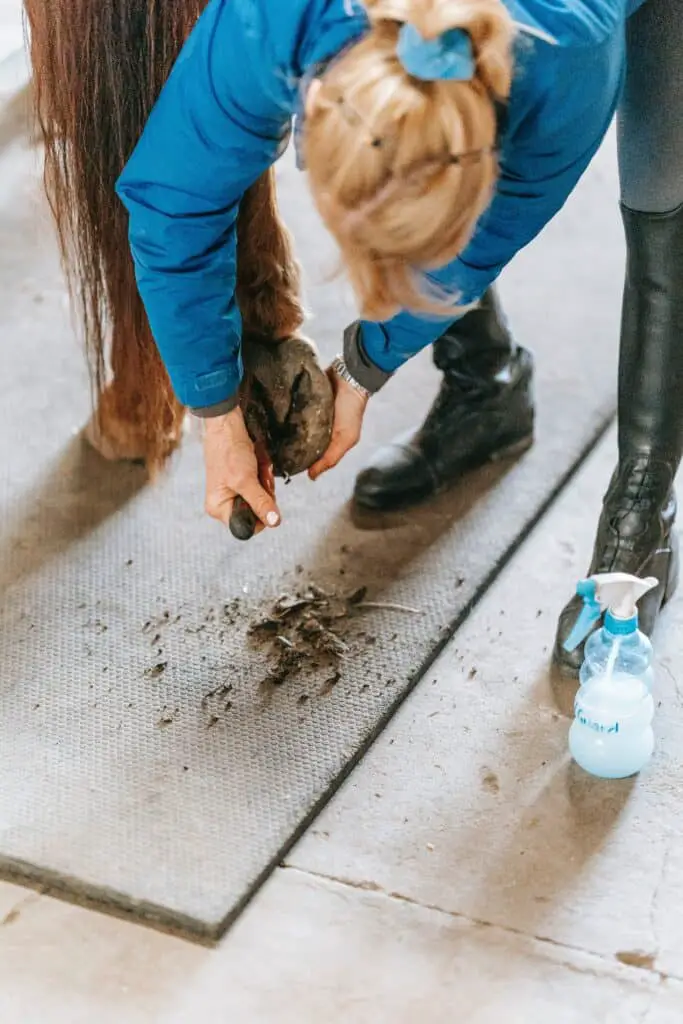
The Anatomy of a Hoof
Before talking about how to prevent or fix overgrown hooves and why they occur, it’s important to be familiar with some of the basic parts of a horse’s hoof.
The Hoof Wall
The hoof wall is the outermost part. This is the external layer which is usually shiny and is the part most of us think of when we think of a “hoof.”
The Frog
This is the soft v-shaped section on the underside of the hoof. During a hoof trimming, any dead flesh will need to be cut off from the frog.
How Do Horse Hooves Overgrow?
There are several ways that a horse’s hooves can overgrow:
Extended Nails
When the nail keeps growing without breaking, the horse’s hoof will grow toward the outside, enlarging their hoof size. This can result in “long” toes or flaring quarters. What this means is that your horse will grow a hoof surface that’s too large or irregularly shaped.
Extended nails can cause the horse to step on themselves, and they can also start over-reaching. With over-reaching, the horse may constantly kick their front hooves with their back hooves when moving. This results in scar tissue, cuts, and swelling on the heels of the front hoof.
An example of extremely overgrown hooves went viral for good reason—it’s unacceptable to leave your horse’s hooves in this severely overgrown condition due to negligence.
Flares
As the name suggests, a horse’s hooves that flare will stretch to the outside (usually from the sides of the hoof), stretching the delicate structure (laminae) that keeps the hoof capsule and nail attached to the inside of the hoof. This is the equivalent to someone pulling your nail away from the nailbed (except a horse has over 800 pounds of pressure on that nail).
Nail and Quarter Breaking
When the nail has grown too long, the surface may break away. If the break is even, the horse will naturally maintain their nail and file it down by walking over rough terrain like stones and sand.
However, the nail may break irregularly, and it can cause a break into the white line or sensitive part of the hoof. This can cause bacteria to enter the hoof, causing hoof rot and cracks that can seriously compromise your horse’s hoof health. White line disease can lead to permanent lameness and eventually necessitate euthanasia.
What Causes Overgrown Horse Hooves?
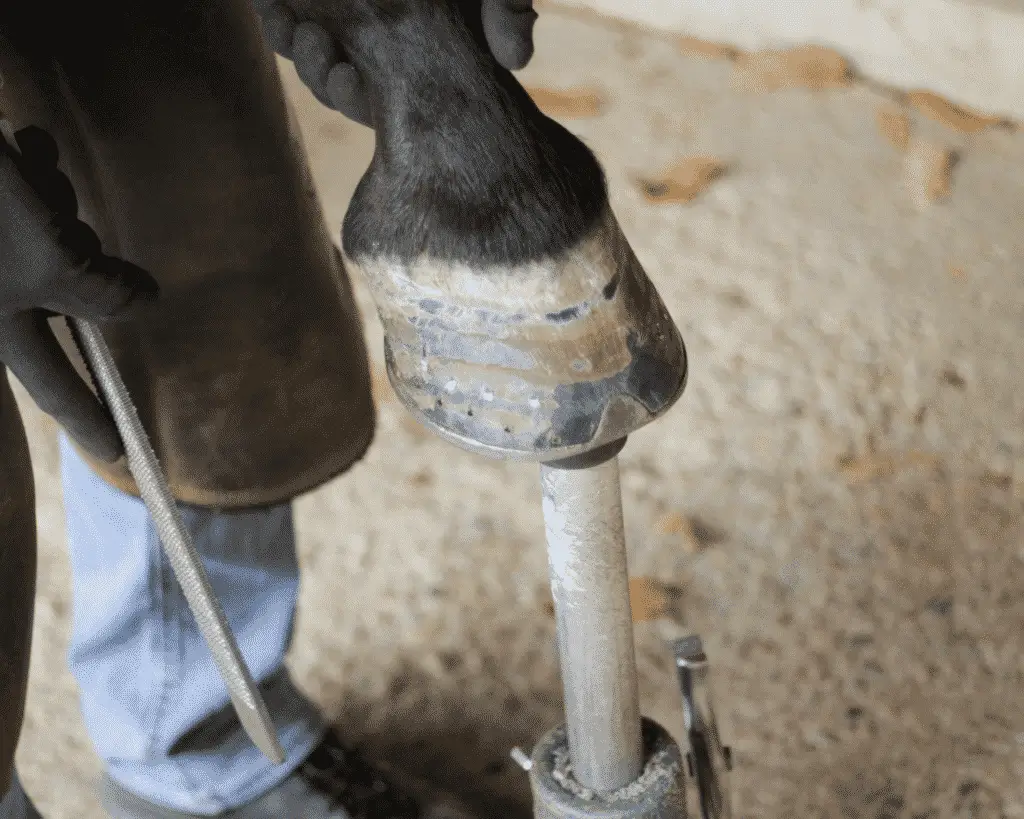
Horses’ hooves are naturally meant to grow. Usually, a horse will require trimming of the hoof nail every six to eight weeks. However, other factors can also cause overgrowth and hoof problems.
Bacteria-Related Hoof Damage
When a horse regularly stands in a muddy corral or paddock and sleeps in a mucky barn, their hooves can be exposed to a range of bacteria that can penetrate the horse’s hooves. Cracks become infected and white line disease can happen.
Incorrect Feeding and Laminitis
Horses love eating, but when you feed them a poorly balanced diet that has too much sugar from grains, molasses, and sweet treats, you are placing them at risk of developing laminitis. Horse owners know how dangerous laminitis is. Many horses don’t recover from laminitis, so it’s best to avoid it altogether.
Laminitis is when the sensitive tissue that holds the hoof capsule in place becomes inflamed and forms serious abscesses. This causes the hoof outer wall to tear away from the inside of the hoof. Lameness, pain, and inability to walk will result from laminitis.
But Don’t Wild Horses Self-Maintain Their Hooves?
This is a popular argument that people have regarding horses and their hooves. The reality is that domestic horses aren’t kept in the same environment as wild horses. In the wild, a horse travels miles and miles each day in the search for grazing. This naturally wears down their hooves.
Today, we keep horses in manicured pastures, feed them excessive sugars and proteins that cause extra hoof growth, and we breed horses that don’t have strong hooves (like thoroughbreds). Because of our interference with the natural way of horses, we need to undertake maintenance to ensure the horses in our care remain sound, can do the work they are bred for, and stay pain-free.
What to Look for When Deciding Whether Your Horse’s Hooves Are Overgrown
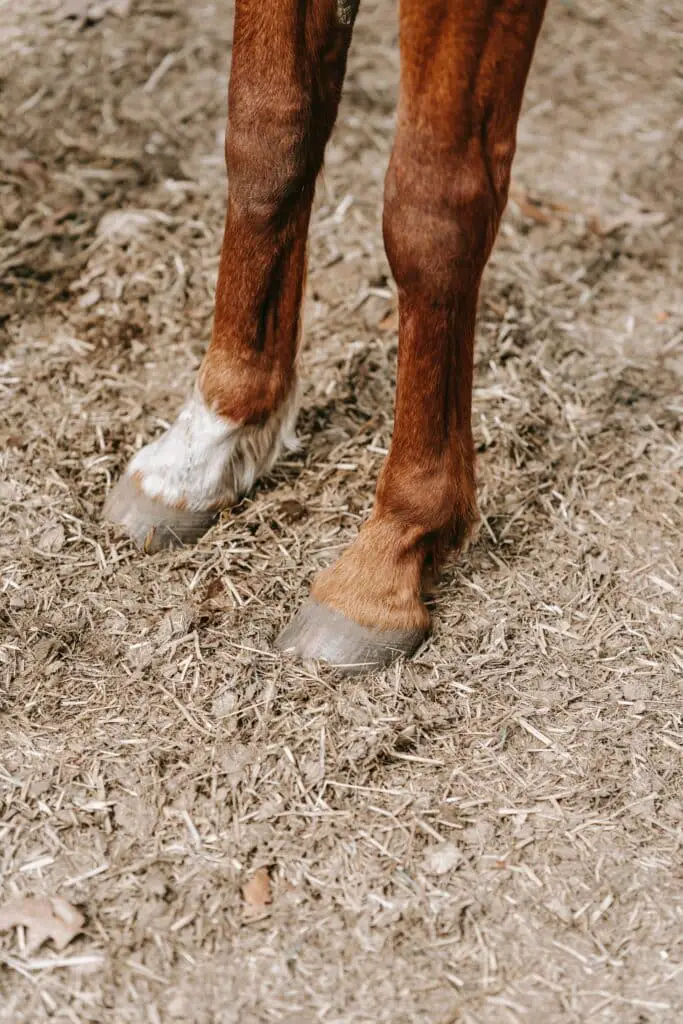
The best advice is to work in close partnership with your farrier. Farriery is a specialized trade that focuses exclusively on the proper care and maintenance of horses’ hooves. If your farrier regularly sees your horse, you can trust them to schedule your horse according to your horse’s hoof growth patterns.
No two horses grow the same type of hoof. There are many different hoof shapes, and past injuries can also influence the unique needs of your horse’s hooves to keep them from becoming overgrown.
Signs of Overgrown Hooves
When you have a new horse and need to decide if it’s time for a farrier to see them, you can look for the following signs that your horse’s hooves are overgrown and need a trim.
1. Visible Signs of Breaking
A horse that has hooves that are too long will probably show signs of splitting edges, broken sections, and odd shaping to their hoof. If you clean your horse’s hooves and notice the shape has changed when viewed from the bottom (usually elongating to the front), then they need a farrier.
2. Vertical Cracks in the Hoof
A horse that has split the hoof capsule will have a crack running up from the nail. If not treated in time, the crack can reach the coronary band. The higher the crack runs, the longer it will take to get it to grow back out and heal the hoof.
3. Thickening of the Bottom Hoof Edge
When the bottom of the hoof edge is thicker than the top, the side view of the hoof will become concave. You can easily test this by placing a ruler from the edge of the horse’s hairline (coronary band) to the bottom of the hoof. If there is a large gap under the ruler, your horse has developed a flare (i.e., the hoof is overgrown).
4. Knocking Sounds
Horses may knock or kick their front hooves with their back hooves when walking if their hooves are overgrown. You can also look for signs of impact on the front hooves. Scarring on the bulbs of the front heels are clear telltale signs that your horse has overgrown their hooves.
5. Sensitivity and Smells
Okay, so a hoof isn’t usually going to smell great. After all, your horse walks around in their stall and paddock, and they walk through manure and mud all day. However, when a horse’s hoof starts to smell rotten, there is a cause.
Usually, when the terrain is very muddy, the cause is thrush or bacterial infection of the soft tissue of the hoof (often the frog area). You can usually tell the difference between the standard barn/manure smell and something that seems less normal and more problematic.
A hoof abscess can also be the cause of a bad smell. An abscess can be caused by an injury, stone bruise, or damage sustained to the hoof. Hooves that are overgrown put uneven pressure on the horse’s feet, which can easily cause an abscess to form. So watch for sensitivity when your horse walks.
Your farrier will be a big help when there’s an abscess as this needs to drain. A good farrier can find the abscess and advise you on caring for the horse’s hoof until the abscess is ready to pop. If it’s close to the surface, a farrier can cut through the hoof to the abscess to help the fluid drain faster.
If any serious problems develop, you may need to enlist the help of your vet in order to prevent lameness and restore your horse to health.
Routine Hoof Care to Ensure Your Horse’s Hooves Remain in Shape
So what can you do to ensure a healthy horse? In addition to making sure to book a farrier and/or vet to regularly trim your horse’s hooves, you need to create a daily hoof care routine.
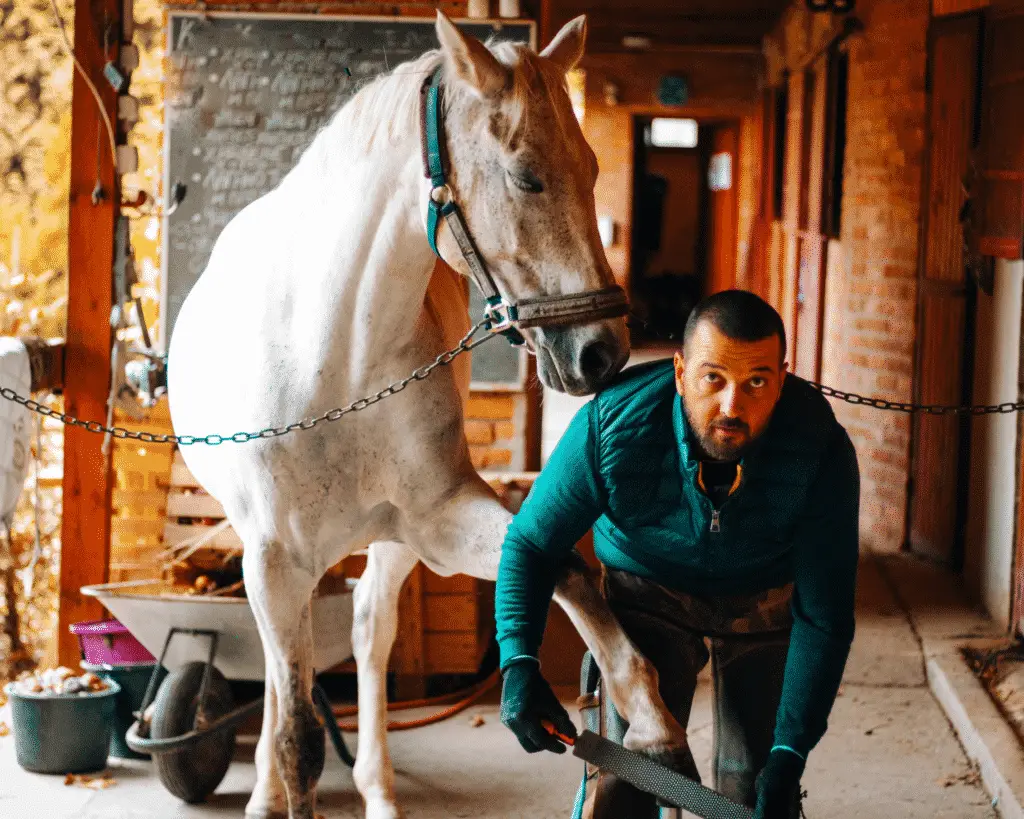
Cleaning Daily
Make picking up your horse’s hooves and picking out stones and dirt a daily routine. The hoof pick and/or hoof knife is your friend.
Daily cleaning will ensure the horse’s frog remains healthy. By removing stones, you prevent stone bruises.
Washing Legs
While it may not seem connected to hoof health, keeping your horse’s legs clean and mud-free can influence how their hooves grow. Washing your horse’s legs when they are muddy can help prevent thrush and other bacterial conditions.
Any cuts or scrapes on or near the coronary band can cause malformations that will grow into the hoof. This will create genetically programmed scar tissue that will cause future problems for your horse.
Rasping the Nail
When your horse’s nails start breaking, it can cause sharpened sections that cut their other legs. Keeping a farrier’s rasp (which is kind of like a nail file) on hand can help when you notice a broken section. Use the rasp to file the sharpened section (along with any jagged edges) until it is in line with the rest of the hoof nail.
If you are unsure of how much to rasp, then focus on only removing the sharp sections.
Moisturize Dry Hooves
Horses can also develop dry hooves, especially when it’s a dry season with little rain. A dry hoof is also more likely to break or split. When a horse’s hoof splits, it can also lead to overgrown sections. Maintaining a healthy moisture level in the hoof is vital for a healthy hoof.
Applying a moisturizing cream such as udder balm or milker’s cream can help your horse’s hooves stay moisturized. While there are hoof oil products available on the market, these are often less beneficial to the horse’s hoof as they seal the hoof, preventing the natural moisture absorption of the hoof.
What Horse Owners Should Know About Preventing Overgrown Hooves
The best way to prevent overgrown hooves is to schedule your horse for regular trimming sessions. Your farrier will be able to advise you on what schedule is appropriate for your horse’s unique hooves.
Some horses do well with a trimming every six to eight weeks. Other horses require more frequent trimming to help manage issues such as flaring, confirmation issues (pigeon-toed, boxed, or cracked hooves), and alignment issues.
Depending on the nature of your horse’s hoof requirements, your farrier may also advise that your horse be shod. This is when the farrier nails on metal shoes to help maintain the horse’s load-bearing surface (or nails). Shoes can help manage cracking, breaking, faulty conformation, and tendon strain.
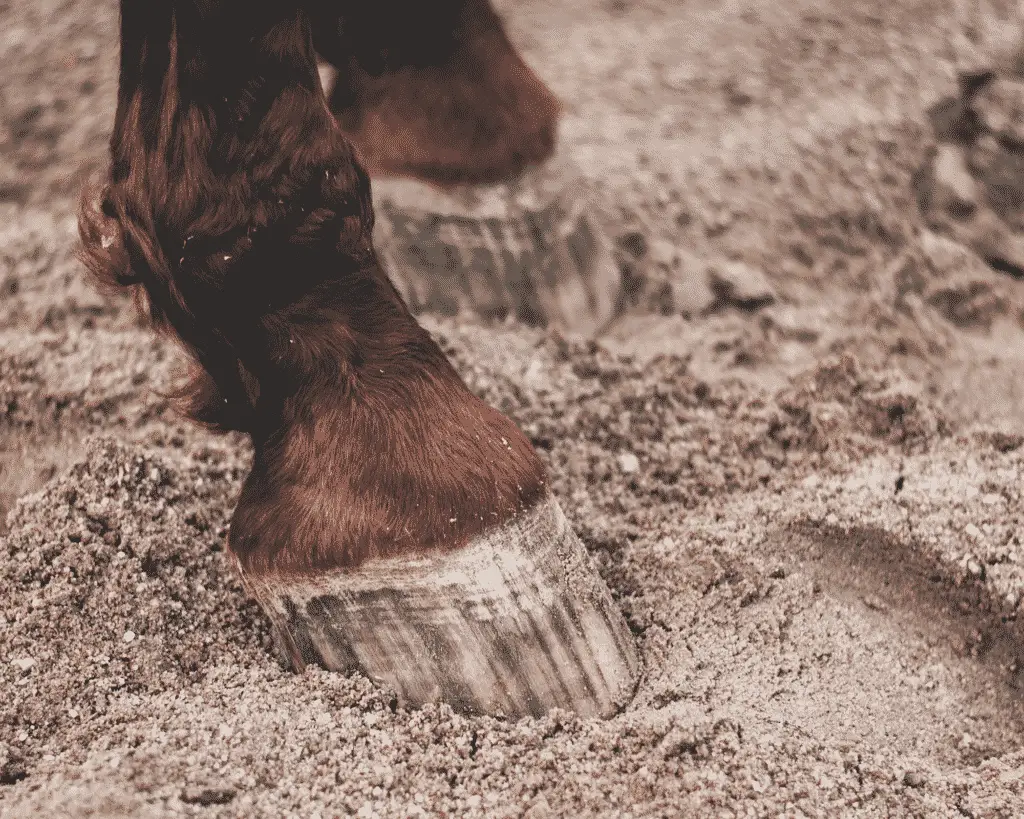
Overgrown Hooves FAQs
Are overgrown hooves painful?
When a horse can’t walk normally due to overgrown hooves, it can be extremely painful for them. The damage to their hooves from overgrowth can also extend to strained muscles, back pain, and even uneven chewing.
What happens if horses’ hooves are not trimmed?
When the hoof wall or nail extends too far due to excessive growth, it can lead to breaking, chipping, cracking, and the development of more long-term problems. The horse’s hooves can develop issues such as abscesses, laminitis, flaring, and in extreme cases, the hoof can become degloved when it catches on something.
Whenever more serious health problems arise, you should always get the help of your veterinarian.
Can overgrown hooves be fixed?
Overgrown hooves can be fixed with regular farrier work. Trimming the hooves every six to eight weeks will ensure the hoof is healthy, the right length, and it doesn’t cause the horse pain. Farrier work is a specialized trade, and only someone who has been trained as a farrier should trim hooves to prevent poor quality trimming that can cause more harm than good.
Overgrown Hooves: You Can Manage It!
Your horse’s hooves are what allow them to move, gallop, and canter about the paddock and trails. Be sure you check your horse’s hooves daily for mud and stones to ensure their hooves remain obstruction-free, and schedule your farrier every six to eight weeks to keep your horse’s nails trimmed to the right length.
Make checking your horse’s hooves part of your daily grooming routine with our guide on Horse Grooming 101.

